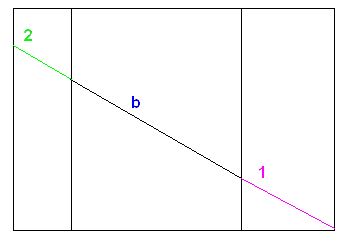Cover's Variable
SIMPLE VARIABLE
General simple variables
Frame simple variables
OBJECT VARIABLE
Please contact technical support for further explanations email: <technical.support@cover3d.com>
→ Bar "b.(a - c - d - f - g - i - l - m - n - o - p - r - s - t - v) "
→ Parent Bar "b.parentB.(same possibilities as Bar "b.")"
→ Dynamic Opening (Opening frame) "CG_OF.(c - v)
→ Dormant "d.(m and also the same possibilities as Structure "s.")"
→ Node "n.(b - c - g - i - m - p - s - v - x - y - z)"
→ Mesh "m.(a - b - c - f - h - i - l - n - o - p - r - s - t - v - w)"
→ Opening "o.(a - c - f - h - m - p - s - t - v - w - x)"
→ Profile "p.(b - c - e - i - l - n - o - p - r - v)"
→ Filling Profile "pf.(d - e - p - v)"
→ Accessories "acc.(i - m - n - p - r - v)
→ Hardware "q.(v)"
→ Structure "s.(a - c - f - p - s - t - v - w - x)"
→ Parent Structure "s.parentS.(same possibilities as Structure "s.")
→ Project "Cg_Project.(i - N)"
SIMPLE VARIABLE
CheckGroupKey(&1)
- return to top list
- Signification: Check if the current license key is in the group of key defined on the parameter &1
- Use case: All
- Conventions:
- Values: Boolean expression (TRUE/FALSE)
- Example: in progress
- Availability : from the version 2.0.1.142
Commercial
- return to top list
- Signification: Test if the current mode is commercial - also see "Fabrication"
- Use case : All
- Conventions :
- Values : Boolean expression (TRUE/FALSE)
- Example : in progress
CurrentID
- return to top list
- Signification: Allows to retrieve the information of the current item in an action of "profile position" or "Action of positioned profile"
- Use case : expression of a parameter of an action of "profile position" or "Action of positioned profile"
- Conventions :
- Values :
- Example : in progress
Fabrication
- return to top list
- Signification: Test if the current mode is fabrication - also see "Commercial"
- Use case : All
- Conventions :
- Values : Boolean expression (TRUE/FALSE)
- Example : in progress
CG_LEVEL
- return to top list
- Signification: allows to test levels of detail in the realization of 3D projects. The level of accuracy is defined by the user using the application menu.The different levels are defined according to a convention established in the configuration When a project is closed, the project is recalculated with the maximum value of CG_LEVEL
- Use case : Frame composition / Conservatory / Curtain wall / Pool cover
- Conventions : CG_LEVEL = 1 at the lowest level; 10 = the highest level
- Values : from 1 to 10
- Example :
If the parametrizer wants to present the information with several levels of accuracy in 3D projects
- 1 = without invisible accessories and without 3D accessories
- 2 = without the accessories not visible
- 10 = all articles of the project
- When installing 3D accessories (for example Act_SetAcc3D which installs this accessory), it is possible to use the test:
- If CG_LEVEL > 1 Then Act_SetAcc3D For the installation of non-visible accessories (ArtNonVisible), the condition of installation would be of the form
- If CG_LEVEL > 2 Then ArtNonVisible (1)
- If we want to test a recalculation at the end of the project, we will use CG_LEVEL>=10 The use of the test in the form >= allows to anticipate a possibility of evolution of the use of CG_LEVEL : 10 being for the moment the highest possible value for the value of CG_LEVEL, but this maximum value could be modified later.
- Availability : from the version 2.1.1.132
CG_MeshCount
- return to top list
- Signification: returns the number of existing meshes in the editor
- Use case : Frame / Gate
- Conventions :
- Values :
- Example : in progress
Fillingtype
- return to top list
- Signification:
- Use case : All
- Conventions :
- Values : Constants prefer FTxxx as numerical value
- All objects = FTALL or -3
- Aerator = FTAERATOR or -1
- Glass= FTGLASS or 0
- Polycarbonate = FTPOLY or 1
- Panel =FTPANEL or 2
- Filling (panel or glazing or polycarbonate) = FTFILLINGS
- 2D structure (chassis)= FTFRAME or 3
- Empty = FTEMPTY
- Filling by profiles= CG_FTPROFILS or 4
- Example : Fillingtype=FTGlass
GroupKey
- return to top list
- Signification: allows you to know the key group in which the user's active license key is associated
- Use case : All
- Conventions :
- Values : numerical if the key is defined in several key groups (available from version 2.0.1.142), GroupKey returns the first group value encountered. When a key number is defined in several groups, it is recommended to use CheckGroupKey
- Example : in progress
Model
- return to top list
- Signification: allows to test the parameter value of the current construction model
- Use case : all
- Conventions :
- Values : numerical
- Example : in progress
NodeTree
- return to top list
- Signification: allows to test the level of kinship of an assembly node using the notion of dependent nodes
- Use case : in the assembly procedure of an assembly node
- Conventions :
- Values : numerical _ 0 : Current node _ 1 : Parent node 1 _ 2 : Parent node 2 _ …
- Example : in progress
ParentModel
- return to top list
- Signification: allows to test the construction model of the parent structure of the current construction model
- Use case : frame
- Conventions :
- Values : value setting of the construction model of the parent structure
- Example : Frame: in an opening, know the value setting of the outer frame construction model
ParentSerie
- return to top list
- Signification: tests the series of the parent structure of the current construction model
- Use case : frame
- Conventions :
- Values : value setting of the serie of the parent structure
- Example : Frame: in an outer frame, know the value setting of the conservatory serie
Serie
- return to top list
- Signification: tests the series of the construction model (beware of the profile series and not the hardware series)
- Use case : All
- Conventions :
- Values : value setting of the current serie
- Example : in progress
Thickness
- return to top list
- Signification: In construction models: at the level of general information: glazing condition: expression in which the compatible filling thicknesses are specified
- Use case : All
- Conventions :
- Values : numerical
- Example : (thickness>=20) and (thickness<=32)
Frame simple variables
Code
- return to top list
- Signification: returns the value associated with an opening system in a construction model. The use of this variable allows to identify the opening system in which we are located.
- Use case : Opening of a frame (stacking of bar, profiles, assembly node, hardware series); stacking of frame structure. (allows to test the code of the sash integrated in the mesh)
- Conventions : This value is defined by the parametrizer (Construction model/compatible opening processes).
- Values : Integer - By default, if no value has been defined: Code=0
- Example : in progress
CodeQ or CodeH
- return to top list
- Signification: returns the value associated with an opening system present in the program's list of openings. The use of this variable makes it possible to identify the current opening system
- Use case : Opening of a frame (stacking of bar, profiles, assembly node, hardware series); stacking of frame structure (allows to test the codeQ or codeH of the sash integrated in the mesh)
- Conventions : This value is defined and imposed by the program
- Values : Integer
- Example : in progress
Hallege
- return to top list
- Signification: returns the height of the sill that was defined by the user when the chassis was created
- Use case : All
- Conventions :
- Values : Float
- Example : in progress
Hpoignee or Hhandle
- return to top list
- Signification:Returns the height of the handle that was chosen by the user when the frame was created. This variable can be used to correctly position the handle items (in hardware actions for example)
- Use case : Open: frame / gates
- Conventions : Hpoignee or Hhandle is calculated by the program from the hardware point.
- Values : float
- Example : in progress
HF
- return to top list
- Signification: allows to test the height of the frame
- Use case : hardware procedure: frames / gates
- Conventions : The value of this variable is calculated on the basis of the "right outer alignment point" point (MRS point) that the program will find on the article sections of each frame bar orientation
- Values : float
- Example : in progress
HQ
- return to top list
- Signification: allows the height of the sash leaf to be tested for the placement of hardware items
- Use case : hardware procedure: frames / gates
- Conventions : The value of this variable is calculated on the basis of the "right outer alignment point" point (MRS point) that the program will find on the article sections of each frame bar orientation
- Values : float
- Example : in progress
Index
- return to top list
- Signification: allows to test the current leaf element of the opening
- Use case : Opening of a chassis: stacking, assembly and hardware
- Conventions : This value is defined and imposed by the program. This is an automatic numbering of the elements of the opening processes starting at 0 from the left when looking at the frame in external view
- Values : integer >=-1
- Note: To test the parent (frame) structure, in a hardware procedure, the Index variable is -1 for standard opening processes, this variable also takes the value of n.vantailcount for dynamic opening processes (available from version 2.1)
- Example : in progress
Indexelement
- return to top list
- Signification: returns the value associated with an element of an opening process.
- Use case : Opening of a chassis (stacking of bar, profiles, assembly node, hardware series)
- Conventions : This value is defined by the parametrizer (Construction model/compatible opening processes).
- Values : Integer, by default, if no value has been defined: Indexelement=0
- Example : in progress
LF
- return to top list
- Signification: allows to test the width of the frame
- Use case : frame ; gate
- Conventions : The value of this variable is calculated on the basis of the "right outer alignment point" point (MRS point) that the program will find on the article sections of each frame bar orientation
- Values : float
- Example : in progress
LQ
- return to top list
- Signification: allows you to test the width of the sash leaf for the placement of hardware items
- Use case : hardware procedure frame ; gate
- Conventions : This variable is calculated on the basis of the "hardware point" point (MRS point) that the program will find on the sections of the articles of each bar orientation of the sash element.
- Values : float
- Example : in progress
PoidsAlu
- return to top list
- Signification: Returns the weight of all profiles of a leaf, an element or a door leaf
- Use case : All
- Conventions :
- Values : float
- Example : total weight of a leaf -> POIDSALU+POIDSVIT or s.weight
- Availability : see also s.weight
PoidsVit
- return to top list
- Signification: returns the weight of all the fillings of a frame
- Use case : All
- Conventions :
- Values : float
- Example : total weight of a leaf -> POIDSALU+POIDSVIT or s.weight
- Availability : see also s.weight
OBJECT VARIABLE
Object bar: b.
b.a...
b.angleorientation
- return to top list
- Signification: allows to test the angle of the bar with respect to the X axis
- Use case : Frame / gates
- Conventions : returns the angle that the bar makes with respect to the horizontal, the bar being traversed in the direction of the end 1 to the end 2
- Values : from 0 to 360
- Example : in progress
b.c...
b.contains(&1)
- return to top list
- Signification: allows to test the presence of one or more profiles on the bar
- Use case : All
- Conventions : Returns the number of times the program finds the profile type item whose name is defined in parameter &1
- &1 : ID of the profile article
- Values : >=0
- Example : I want to know if a profile with an item with the NAME "P10" is present on the current bar. -> B.contains(P10)>0
b.containsline(&1)
- return to top list
- Signification:Allows to know if one or more profiles present on the bar contain in their section(s) a line whose parameter value is defined in the parameter &1
- Use case : All
- Conventions : The program scans all the profiles on the bar and returns the number of profiles that contain this line
- Values : >=0
- Example : I want to know if one of the profiles on the bar has a line with a parameter value of 105 -> b.containsline(105)>0
b.containspoint(&1)
- return to top list
- Signification: Allows to know if one or more profiles present on the bar contain in their section(s) a point whose parameter value is defined in the parameter &1
- Use case : All
- Conventions : The program scans all the profiles on the bar and returns the number of profiles that contain this point
- Values : >=0
- Example : I want to know if one of the profiles on the bar has the point whose parameter value is equal to 105 -> b.containspoint(105)>0
b.containsstyle(&1)
- return to top list
- Signification: allows to test the property of the bars leading to the intermediate nodes of the current bar
- Use case : All
- Conventions : The program only runs through the intermediate nodes of the bar. The end nodes, N1 and N2, are not taken into account in the calculation
- Values : >=0
- Example : in a conservatory
- I want to test on the Hiprafter if Planerafter bars end up on it
- if b.containsstyle(BSPLANERAFTER)>0 else or b.containsstyle(104)>0
- also see "bar style conventions"
b.currentmeshside
- return to top list
- Signification: Allows to know on which side of the bar, mesh side 1 or mesh side 2, we are located
- Use case : All of them. Position of the mesh in the bar. Use in the mesh stacking of a profile.
- Values : 0 to 4
- Mesh side 1 = 0
- Mesh side 2 = 1
- Mesh side 3 = 2
- Mesh side 4 = 3
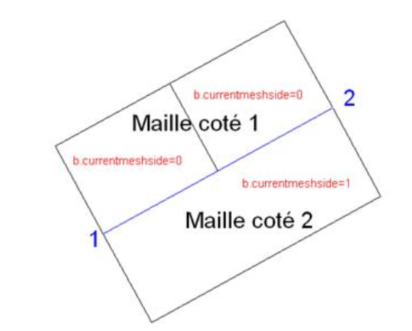
b.d...
b.distance1
- return to top list
- Signification: Allows to test the distance from node 1 of the current crossbar to the nearest frame type bar in the direction of the bar
- Use case : Frame; crossbar type bar
- Values : >= 0
- Example : The distance in fuchsia represents b.distance1 for the bar b
b.distance2
- return to top list
- Signification: Allows to test the distance from node 2 of the current crossbar to the nearest frame type bar in the direction of the bar
- Use case : Frame; crossbar type bar
- Values : >= 0
- Example : The distance in green represents b.distance2 for the bar b
b.f...
b.fillingtype1(&1) b.fillingtype2(&1) b.fillingtype3(&1) b.fillingtype4(&1)
-
Signification: Allows to test the number of meshes to the left of a bar that contain a filling whose type is defined in parameter &1
-
Use case : All
-
Parameter : &1 : the type of filling (glazing, panel,...) see m.fillingtype
-
Values :
- using the constants (highly recommended):
- Aerator = FTAERATOR
- Glazing = FTGLASS
- polycarbonate = FTPOLY
- Panel =FTPANEL
- 2D structure = FTFRAME
- using the numerical values :
- -1 = Aerator
- 0 = glazing
- 1 = polycarbonate
- 2 = Panel
- 3 = 2D structure (frame)
- using the constants (highly recommended):
-
Example : We want to know whether in the left-hand meshes adjacent to the current bar, there is at least one mesh that contains a glazing-type filling:
-
b.fillingtype1(FTGLASS)>0
-
b.fillingtype1(0)>0
b.FindStyleInPlane1(&1) b.FindStyleInPlane2(&1) b.FindStyleInPlane3(&1) b.FindStyleInPlane4(&1)
- return to top list
- Signification: is used to test the number of bars, whose style is specified in parameter &1, and which are in the plane defined by mesh 1-2-3 or 4 of the current bar.
- Use case : All
- Conventions : The program goes through all the bars found in the plane of the mesh, making sure to take only those that can be linked to the current bar by means of meshes.
- Value parameter: &1: style of the bar see bar pilling-up
- Example : I want to know if on the plan mesh 1 a Gutter is present
- b.FindStyleInPlane1(BSGUTTER)>0
- b.FindStyleInPlane1(101)>0
b.g...
b.GABname
- return to top list
- Signification: returns the name of the bending sequence of a bar
- Use case : All
- Conventions : as we are testing a string of characters we need to add inverted commas on either side of the template name we wish to test
- Values : String
- Example : I want to know the name of a bended bar is " curved_01"
- b.GABname="curved_01"
- Availability : since 2.0
b.i...
b.Id
- return to top list
- Signification: Returns the number of the bar being calculated.
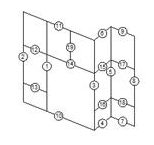
- Use case : All
- Conventions : Numbering starts at "0". The identification of bars at document level starts at "1". To get the correspondence, use "b.Id +1".
- Values : >=0
b.IdOnNode(&1)
- return to top list
- Signification: allows to know the index of the bar in one of the intermediate or end nodes of this same bar
- Use case : All
- Conventions : The function returns '-1' if the specified index is incorrect
- Parameter : &1: node index on the bar
- Notice: the numbering of the nodes on the bar starts at 0
- node 1 of the bar : &1=0
- node 2 of the bar : &1=b.nodecount-1
- Values : >=-1
- Example :In a veranda, at node 1 of a bar, I want to know if the angle formed on the ground between the bar of index 0 and the current bar is equal to 180°:
- (b.n1.groundmeshesangle(0;b.IdOnNode(0))=180
- Availability :
b.interiorangle
- return to top list
- Signification: is used to test the interior angle between the two meshes of a bar
- Use case : All except Frame
- Values : Float
b.l...
b.leftmodel
- return to top list
- Signification: allows to test the value of the MODEL variable of the structure (frame) found in the first mesh on the left of the current bar
- Use case : Struture with a frame in a mesh
- Conventions :
- Values : Value of the simple model variable of the frame construction model
- Example :On a veranda post bar, we want to know the frame present in the left mesh by testing the parameter value of the frame construction model.
b.leftserie
- return to top list
- Signification: allows to test the value of the SERIES variable of the structure (frame) found in the first mesh on the left of the current bar
- Use case : Struture with a frame in a mesh
- Values : value of the simple serie variable
b.length
- return to top list
- Signification: allows to test the length of a bar
- Use case : All
- Values : Float
b.m...
b.meshcount1 b.meshcount2 b.meshcount3 b.meshcount4
- return to top list
- Signification: allows you to test the number of meshes side 1-2-3 or 4 of the current bar
- Use case : All
- Values : >=0
b.meshnormale(&1)
- return to top list
- Signification: is used to test the direction of the normal of a mesh of the bar whose side is specified in parameter &1. The normal of a mesh allows to know the orientation of this one, it defines the external side of the mesh.
- Use case : All
- Parameter : &1: Mesh Side: side(s) of the bar to be taken into account in the calculation of the variable
- Mesh side 1 of the bar: 1 or the constant sleft
- Bar side 2 mesh: 2 or the constant sright
- Bar side 3 mesh: 3 or constant sdown
- Mesh side 4 of the bar: 4 or the constant sup
- Values : Viewing the bar in the extrusion direction (from 1 to 2)
- "+1" = if the normal of the mesh follows the trigonometric direction (anti-horlogical)
- "-1" = if the normal of the mesh follows the clockwise direction
- "0" = if the bar does not contain a mesh on the side specified in the variable
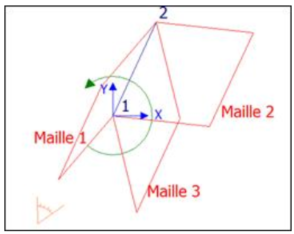
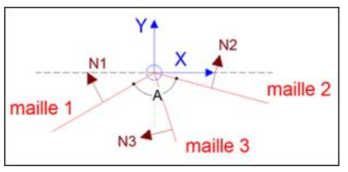
- N1 : normal of a mesh 1
- b.meshnormale(Sleft)=-1
- N2 : normal of a mesh 2
- b.meshnormale(Sright)=+1
- N3 : normal of a mesh 3
- b.meshnormale(Sdown)=-1
- N4 : normal of a mesh 4
- b.meshnormale(Sup)=+1
- Example : In a veranda, I would like to know if the outside of the meshes on side 3 (meshes at the bottom) are on the left or on the right in order to correctly position the frame below:
- In the example below, the outside of the mesh is on the left, i.e. the function b.meshnormal(sdown) will be equal to -1
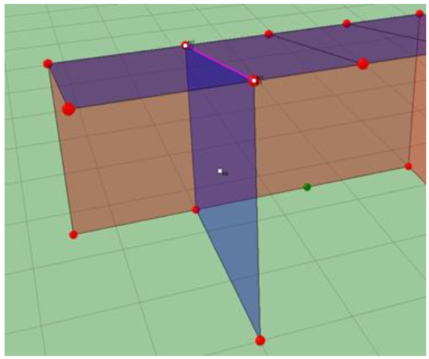
- Availability :
b.modelcount(&1;&2)
- return to top list
- Signification: is used to test the number of 2D constructions (frames) present in the meshes of one or both sides of the bar (parameter &1) and which have the value of the construction model (simple variable MODEL) defined in parameter &2 of the variable.
- Use case : Structure with a frame in a mesh
- Parameter : is used to test the number of 2D constructions (frames) present in the meshes of one or both sides of the bar (parameter &1) and which have the value of the construction model (simple variable MODEL) defined in parameter &2 of the variable.
-
&1
- Mesh side 1 of the bar: 1 or the constant sleft
- Bar side 2 mesh: 2 or the constant sright
- Bar side 3 mesh: 3 or constant sdown
- Mesh side 4 of the bar: 4 or the constant sup
-
&2 -Value of the simple model variable of the frame construction model
-
- Values : >=0
-
Example 1 : for the positioning of a post, I would like to know if I have at least one sliding frame in one of the meshes to the right of the bar and whose frame construction model setting value is 7012 :
- b.modelcount(sright ;7012)>0
-
Example 2 : for the positioning of a post, I would like to know if I have at least one sliding frame in one of the adjacent bar meshes and whose frame construction model setting value is 7012 :
- b.modelcount(sright+sleft ;7012)>0
-
b.n...
b.n1.
- return to top list
- Signification: allows access to the object variables of node 1 of the current bar
- Use case : all
- Conventions :
- Values : See the variables of the object n
- Example : on a conservatory, on a hip bar, I would like to know if I have more than one single ridge bar (b.style=103) that ends at node 1 of this bar : If b.n1.contains(beamstyles ;103)>1 Then...
- Availability :
b.n1leftcontactangle
-
Signification: allows you to know the contact angle to the left of the bar at node 1
-
Use case : all
-
Conventions : It is imperative that there is a mesh between the two bars. If not, use the variable n.meshesangle(&1;&2) through the node object (b.n1.meshesangle(&1;&2) OR b.n2.meshesangle(&1;&2)).
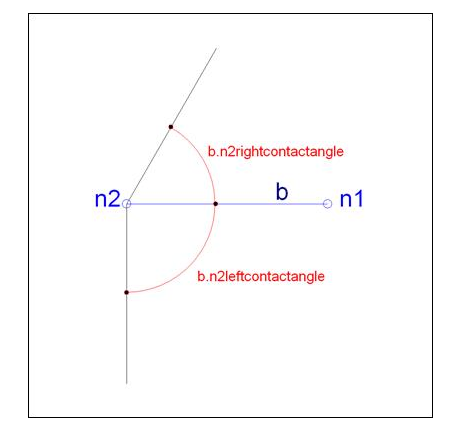
-
Values : >=0
-
Example : in progress
-
Availability :
b.n1rightcontactangle
- return to top list
- Signification: allows you to know the contact angle to the right of the bar at node 1
- Use case : all
- Conventions : see the variable b.n1leftcontactangle
- Values : >=0
- Example : in progress
- Availability :
b.n2.
- return to top list
- Signification: allows access to the object variables of node 2 of the current bar
- Use case : all
- Conventions :
- Values :See the variables of the object n
- Example : In a frame, on a bar, I want to know if node 2 of the bar is a node of position 2 (see n.position) : If b.n2.position=2 then...
- Availability :
b.n2leftcontactangle
- return to top list
- Signification: allows you to know the contact angle to the left of the bar at node 2
- Use case : all
- Conventions : see the variable b.n1leftcontactangle
- Values : >=0
- Example : in progress
- Availability :
b.n2rightcontactangle
- return to top list
- Signification: allows you to know the contact angle to the right of the bar at node 2
- Use case :
- Conventions : see the variable b.n1leftcontactangle
- Values : >=0
- Example : in progress
- Availability :
b.nodecount
- return to top list
- Signification: returns the number of nodes present on the current bar
- Use case : all
- Conventions :
- Values : >=2
- Example : in progress
- Availability :
b.o...
b.orientation
- return to top list
- Signification: allows to test the orientation of a bar in a frame
- Use case : Chassis (frame or crossbar type)
- Conventions :
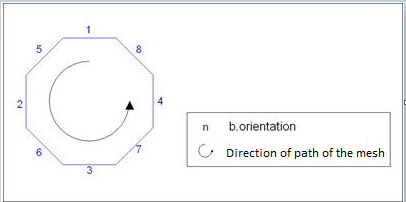
Note 1: Using the variable for a transom To determine the orientation of a transom-type bar
-
Horizontal : convention : from right to left (seen from the outside)
-
Orientation bar 1
-
Vertical : convention : from top to bottom (seen from the outside)
-
Orientation bar 2
-
Oblique : depends on the oblique :
-
If closest to vertical, including 45° angle: the direction of the bar is that of a vertical crossbar: Orientation bar 6 or 5
-
If it is closest to the horizontal (not including a 45° angle): the direction of the bar is that of a horizontal crossbar: Orientation bar 8 or 5
Orientations 3; 7; 4 are therefore never used for transoms.
Attention: this rule is no longer valid for hardware. For the calculation of the hardware, the program calculates the orientation of the bars as for the frames (same direction of travel of the mesh)

Note 2: Tolerance for a horizontal or vertical bar:
The tolerance applied by the program for the passage of a horizontal or vertical bar to an oblique bar is +/- 0 .57° (or 1/100 radians)
Example : A bar of orientation 3 changes into a bar of orientation 6 or 7 when the angle between the horizontal and the bar is greater than +/- 0.57°.
- Values : from 1 to 8
- Example : in progress
- Availability :
b.p...
b.paramvalue
- return to top list
- Signification: allows you to test the value of the bar stacking settings see in the general info of the bar stacking (BAR PILLING-UP)
- Use case : all
- Conventions : the parameter value of a bar stack is set by the parameterizer. The default value when creating a bar stack is 0
- Values : numeric
- Example : in progress
- Availability :
b.parentb
- return to top list
- Signification: allows to access the information of the adjacent bar of the parent structure
- Use case : Frame (to access the information of a bar of a structure such as a conservatory, curtain wall or frame composition)
- Conventions : The expression b.parentb. then replaces the expression b. in the bar of the parent structure Note: If we are in a frame that is not integrated in a parent structure (frame only), the value returned by b.parentb corresponds to the current bar
- Values :
- Example : In a roof frame, for a bar parallel to the rafter the roof slope can be accessed as follows: If (b.orientation=2 OR b.orientation=4) Then b.parentb.slope ...
- Availability :
b.r...
b.realslope2
- return to top list
- Signification: Slope of the roof mesh on an oblique gutter bar
- Use case : Conservatory : oblique gutter bar
- Conventions : see property of an oblique gutter bar
- Values : >=0
- Example : used in the Rz parameter of the positioned profile action of the oblique gutter
- Availability :
b.rightmodel
- return to top list
- Signification: allows to test the value of the MODEL variable of the structure (frame) found in the first mesh on the right of the current bar
- Use case : Conservatory, curtain wall, frame composition
- Conventions :
- Values : Value of the simple model variable of the frame construction model
- Example : in progress
- Availability :
b.rightserie
- return to top list
- Signification: allows to test the value of the SERIES variable of the structure (frame) found in the first mesh on the right of the current bar
- Use case : Conservatory, curtain wall, frame composition
- Conventions :
- Values : value of the simple variable serie
- Example : in progress
- Availability :
b.s...
b.seriecount(&1;&2)
-
Signification: allows to test the number of 2D constructions (frames) present in the meshes of one, or both sides of the bar (parameter &1) and which have the value of the series (simple variable SERIE) defined in the parameter &2 of the variable.
-
Use case : conservatory, frame composition, curtain wall
-
Conventions :
-
Parameter :
-
&1 : side of the bar where we want to test the number of frames with the value of the series specified in &2 :
-Mesh side 1 of the bar : 1 or the constant sleft -Mesh side 2 of the bar : 2 or the constant sright -Mesh side 1 and 2 of the bar: 1+2 or the constant sright+sleft -Mesh side 3 of the bar : 3 -Mesh side 4 of the bar : 4
-
-
&2 : Value of the simple variable SERIE of the frame
-
Values : >=0
-
Example-1 : for the positioning of a post, I want to know if I have at least one sliding frame in one of the meshes on the right of the bar and whose frame series parameter value is 1000 : If b.seriecount(sright ;1000)>0 Then... -Example-2 : for the positioning of a post, I want to know if I have at least one sliding frame in one of the adjacent bar meshes and whose frame series setting value is 7012 : If b.seriecount(sright+sleft ;1000)>0 Then...
-
Availability :
b.slope
- return to top list
- Signification: allows you to test the slope of the current bar
- Use case : All except frame and gate
- Conventions :
- Values : >=0 (in degrees)
- Example :
- Availability :
b.slope1
- return to top list
- Signification: allows to test the angle of the slope of the mesh on side 1 of the bar
- Use case : All except chassis
- Conventions :
- Values : numeric (in °)
- Example : in progress
- Availability :
b.slope2
- return to top list
- Signification: allows you to test the angle of the slope of the mesh on side 2 of the bar
- Use case : All except frame and gate
- Conventions :
- Values : numeric (in °)
- Example : in progress
- Availability :
b.style
- return to top list
- Signification: allows you to test the current bar style
- Use case : all
- Conventions : see in the general info of the bar stacking (BAR PILLING-UP)
- Values : >=0
- Example : In a conservatory : place a profile if it is a rafter bar (BSPLANERAFTER) or a hip bar (BSHIPRAFTER) If (b.style=BSPLANERAFTER) OR (b.style=BSHIPRAFTER) Then...
- Availability :
b.subproperty1
- return to top list
- Signification: this variable returns the value associated with the first field of the "PRO" property of a bar in the application
- Use case : all
- Conventions :
- Values : numeric
Note: defined on the wire structure (Bar selection + Bar property)
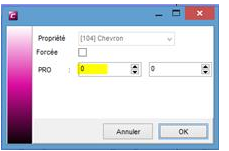
-
This value can also be defined in the parametric shape editor during the bar parametrization phase
-
This value can also be set in the division editor using functions SP_BS or SP_B
-
Example :
-
Availability :
b.subproperty2
- return to top list
- Signification: this variable returns the value associated with the second field of the "PRO" property of a bar in the application
- Use case : all
- Conventions :
- Values : numeric Note: defined on the wire structure (Bar selection + Bar property)
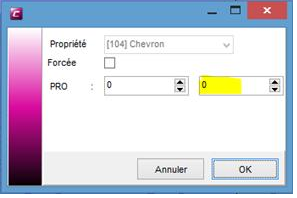
The other techniques for defining subproperty values are only valid for subproperty1
- Example : in progress
- Availability :
b.t...
b.tgslope1
- return to top list
- Signification: returns the value of the slope of the tangent to the mesh curve on side 1 of the bar
- Use case : Pool covers
- Conventions :
- Values : numeric (in °)
- Example : in progress
- Availability :
b.tgslope2
- return to top list
- Signification: renvoie la valeur de la pente de la tangente à la courbe de la maille côté 1 de la barre
- Use case : Pool covers
- Conventions :
- Values : numeric (in °)
- Example : in progress
- Availability :
b.thickness
-
Signification: Allows you to test the greatest thickness of the fills or frames adjacent to the bar (greatest thickness among all the meshes on side 1, 2, 3 or side 4)
-
Use case : all (see the variable b.thicknessMax)
-
Values : >=0
-
Conventions : Thickness value :
- Thickness of a filling: value of the thickness parameter in the filling item
- Thickness of a structure (frame): calculated on the basis of the MRS type point "thickness point" set on a frame profile.
Note:
To calculate the thickness of a frame, the program returns the value of the "Y" coordinate of the thickness point on the section
- Values : >=0
- Example : in progress
- Availability :
b.thickness1
- return to top list
- Signification: allows to test the greatest thickness of the internal objects of the meshes (fillings or frames) meshes side 1 of the bar (greatest thickness among all the meshes side 1)
- Use case : all (see the variable b.thicknessMax)
- Conventions : Same as b.thickness
- Values : >=0
- Example :
- Availability :
b.thickness2
- return to top list
- Signification: allows to test the greatest thickness of the internal objects of the meshes (fillings or frames) side 2 of the bar (greatest thickness among all the meshes side 2)
- Use case : all (see the variable b.thicknessMax)
- Conventions : Same as b.thickness
- Values : >=0
- Example : in progress
- Availability :
b.thickness3
- return to top list
- Signification: allows to test the greatest thickness of the internal objects of the meshes (fillings or frames) side 3 of the bar (greatest thickness among all the meshes side 3)
- Use case : all (see the variable b.thicknessMax)
- Conventions : Same as b.thickness
- Values : >=0
- Example : in progress
- Availability :
b.thickness4
- return to top list
- Signification: allows to test the greatest thickness of the internal objects of the meshes (fillings or frames) side 4 of the bar (greatest thickness among all the meshes side 4)
- Use case : all (see the variable b.thicknessMax)
- Conventions : Same as b.thickness
- Values : >=0
- Example : in progress
- Availability :
b.thicknessMax(&1 ;&2 ;&3)
- return to top list
- Signification: allows to test the greatest thickness of internal objects of meshes adjacent to the bar, whose type of object is defined in parameter &3, the type of mesh in parameter &2 and the side of the mesh in parameter &1
- Use case : all
- Conventions : Same as b.thickness
- Parameter :
-
&1 : Mesh Side : side(s) of the bar to take into account in the calculation of the variable -Mesh side 1 of the bar : 1 or the constant sleft -Mesh side 2 of the bar : 2 or the constant sright -Mesh side 3 of the bar : 3 or the constant ? -Mesh side 4 of the bar : 4 or the constant ? -All sides : SEXPALL
-
&2 : Mesh Type : Type of mesh to take into account in the calculation of the variable -Vertical mesh : constant MTVertical -Horizontal mesh: constant MTHorizontal -Oblique mesh (roof mesh): constant MTOblique -All mesh types: constant MTAll
-
&3 : Filling Type : Type of mesh objects to be taken into account in the calculation of the variable
-
Note: In the case of a frame the meshes are horizontal
-
&3 : Filling Type : Type of mesh objects to be taken into account in the calculation of the variable see the variable m.fillingType
-
Values : >=0
-
Example : Conservatory: On a rafter bar, I want to know the greatest thickness of filling in the roof without taking into account the frames :
b.thicknessmax(SExpAll ;MTOBLIQUE ;FTFillings)
- Availability :
b.thicknessMin(&1 ;&2 ;&3)
- return to top list
- Signification: allows to test the smallest thickness of internal objects of meshes adjacent to the bar, whose object type is defined in parameter &3, the type of mesh in parameter &2 and the side of the mesh in parameter &1
- Use case : all
- Conventions : Same as b.thickness
- Parameter : (see the variable b.thicknessMax)
- Values :
- Example :
- Availability :
b.v...
b.variable_integer(&1)
- return to top list
- Signification: expression allowing to test a variable of the tree of a bar
- Use case : all
- Conventions :
- Parameter : &1 : name of the text object assigned to the variable
- Values :
- Example :
- Availability :
b.variable_float(&1)
- return to top list
- Signification: expression allowing to test a variable of the tree of a bar
- Use case : all
- Conventions :
- Parameter : &1 : name of the text object assigned to the variable
- Values :
- Example :
- Availability :
b.vnodes(&1)
- return to top list
- Signification: allows access to the variable of the object of an intermediate node of a bar
- Use case : All
- Conventions : see also variable b.nodecount
- Values : 0 to n (&1)
- &1: index of the node, on the bar, to be accessed
- the numbering of the nodes on the bar starts at 0 :
- &1 = 0 = node 1 of the bar
- b.n1. = b.Vnodes(0).
- b.n2. = b.Vnodes(b.nodecount-1)
- Example : On the channel bar, here is what the node indexes are worth:
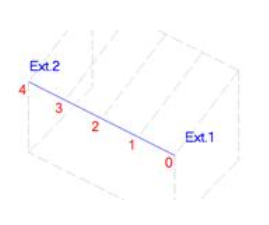
Object Dynamic Opening: CG_OF.
CG_OF.c...
CG_OF.Code
- return to top list
- Signification: returns the parameter value defined in the opening process object - see : code
- Use case :
- Conventions :
- Values :
- Example :
- Availability :
CG_OF.CodeQ
- return to top list
- Signification: see the value defined at the opening process object - see codeq
- Use case :
- Conventions :
- Values :
- Example :
- Availability :
CG_OF.Count
- return to top list
- Signification:
- Use case : all
- Conventions :
- Values :
- Example :
- Availability :
CG_OF.v...
CG_OF.Variable_Float(&1)
- return to top list
- Signification: returns the value associated with the variable designated by &1 as a decimal number
- Use case : opening definition procedure
- Conventions :
- Parameter : &1 : name of the text object assigned to the variable
- Values :
- Example :
- Availability :
CG_OF.Variable_Integer(&1)
- return to top list
- Signification: returns the value associated with the variable designated by &1 as an integer
- Use case : opening definition procedure
- Conventions :
- Parameter : &1 : name of the text object assigned to the variable
- Values :
- Example :
- Availability :
CG_OF.Variable_String(&1)
- return to top list
- Signification: returns the value associated with the variable designated by &1 as a string
- Use case : opening definition procedure
- Conventions :
- Parameter : &1 : name of the text object assigned to the variable
- Values :
- Example :
- Availability :
Object Dormant: D.
D.m...
D.Model
- return to top list
- Signification: Value of the variable MODEL of the frame
- Use case : Opening sytstem (Frame, Gate,...)
- Values : Integer
Object Node: N.
N.b...
n.beamcount
- return to top list
- Signification: allows to know the number of bars composing the node
- Use case : all
- Conventions :
- Values : The numbering of the bars starts at 1 >0
- Example :
- Availability :
n.beam_orientation(&1)
-
Signification: allows to know the orientation of a bar present in the node
-
Use case : frame
-
Conventions : To know the orientation values of a bar, see b.orientation
-
Parameter : &1 : index of the bar, in the assembly node, whose orientation we want to know
-
Values : >=0
-
Example : in progress
-
Availability :
-
Note: The result of this variable can also be found using: n.vbeams(&1).orientation
N.c...
n.codeq(&1)
- return to top list
- Signification: Allows to test the presence of an opening system (by means of the codeq) in a mesh of the node, whose index is specified in the parameter &1
- Use case : frame
- Conventions :
- Parameter : &1 : Index of the mesh, in the assembly node, whose codeq value we wish to know
- Values : see codeq
- Example : in progress
- Availability :
n.contains(beamstyles;&1)
- OLD PARAMETER SEE AVAILABILITY
- return to top list
- Signification: allows you to test the number of bars leading to the node whose style is specified in parameter &1
- Use case : All
- Conventions : see bar property
- Values : >= 0
- Example :Is there a Gutter in the assembly node? (The style of a shoreline bar is BSGUTTER)
If n.contains(beamstyles;BSGUTTER)>0 Then...
- Availability : The function n.contains(beamstyles; &1) is depreciated from version 2.1 and replaced by n.containsBS(&1), for technical reasons related to the preparation of libraries in compiled mode
n.containsBS(&1)
-
Signification: allows you to test the number of bars leading to the node whose style is specified in the &1 parameter
-
Use case : all
-
Conventions : see in the general info of the bar stacking (BAR PILLING-UP)
-
Parameter : &1 : Style of the bar : see b.style
-
Values : >0
-
Example : Is there a edge bar in the assembly node? (The style of an edge bar is BSENDRAFTER)
If n.contains(beamstyles; BSENDRAFTER)>0 Then...
n.containsline(&1)
- return to top list
- Signification: returns the number of profiles ending at the node that contain the line whose parameter value is specified in parameter &1
- Use case : all
- Conventions :
- Parameter : &1 : Parameter value of the line to be tested
- Values : >=0
- Example : in progress
n.containsnames(&1)
- return to top list
- Signification: allows to test the number of profiles present on the bars leading to the node and whose name is specified in the parameter &1
- Use case : all
- Conventions : The purpose is to test profile items, whose extrusion is done at the bar or at the mesh.
The program scans all the bars of the node and returns the number of times it finds the profile item whose name is defined in parameter &1.
-
Parameter : &1 : name of the material object of type profile whose presence at the node is to be known
-
Values : >0
-
Example : Are there 2 frame_TH_52 profiles that end at the assembly node?
If n.containsnames("dormant_TH_52")=2 Then...
N.g...
n.groundmeshangle(&1)
- return to top list
- Signification: allows to know the projected angle on the ground of the mesh indicated in parameter &1 in a node.
- Use case : Conservatory, frame composition, curtain wall
- Conventions :
- Parameter : &1 : index of the mesh in the assembly node for which we want to know the value of the angle projected on the ground
- Values : >=0
- Example : in progress
n.groundmeshesangle(&1 ;&2)
-
Signification: allows to calculate the angle projected on the ground between two bars
-
Use case : Conservatory, frame composition, curtain wall
-
Conventions : The program calculates the angle in the plane formed by the two bars projected on the ground. The angle is given starting from the bar of index 1 towards the bar of index 2 in the trigonometric direction (anti-horlogical direction).
-
Parameter : in progress
- &1 : Index of the bar1
- &2 : Index of the bar2
-
Values :
-
Example :
N.i...
n.indexnode(&1)
- return to top list
- Signification: allows to know the index of the node in the bar specified in parameter &1 (see also the variable b.vnodes()
- Use case : all
- Conventions :
- Parameter : &1 : Index of the bar in the node
- Values : >=0
Note: If the program does not find the bar, the variable returns the value -1
- Example : in the conservatory, at a rafter-gutter node, to get the information from the previous node of the gutter bar
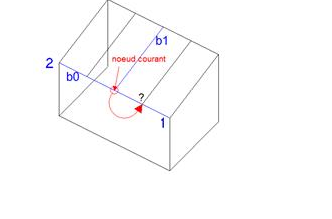
The previous node corresponds to :
n.Vbeams(0).Vnodes(n.indexnode(0)-1)
In this expression :
n.Vbeams(0). Vnodes(n.indexnode(0)-1) allows to access the bar (index 0)
n.Vbeams(0).Vnodes(n.indexnode(0)-1) : allows, once in the oak bar, to reach an intermediate node of this one.
Reminder: In the example bar gutter, the nodes have the following indices:

n.Vbeams(0).Vnodes(n.indexnode(0)-1) : n.indexnode(0) returns the current node (here 2), and the -1 allows to access the previous node (here 1)
N.m...
n.meshangle(&1)
- return to top list
- Signification: allows to test, at the node, the angle of a mesh formed by the two bars delimiting and whose index in the node is defined in parameter &1
- Use case : all
- Conventions :
- Parameter : &1: Index of the mesh in the node whose angle we want to know
- Values : >=0 and <=360. value given in °
- Example : In the frame: We wish to test the angle between the bar of index 0 (b0) and the bar of index 2 (b2). These two bars define the mesh of index 1 (m1)

The expression to write to do the test is the following:
n.meshangle(1) = ....
- Availability :
n.meshcount
- return to top list
- Signification: Allows you to test the number of stitches that make up an assembly node
- Use case : all
- Conventions :
- Values : >0
- Example : in progress
- Availability :
n.meshesangle(&1 ;&2)
- return to top list
- Signification: is used to calculate, at the node, the angle between two bars whose indices are given in parameters &1 and &2
- Use case : all
- Conventions : The program calculates the angle in the plane formed by the two bars. The angle is given starting from the bar of index 1 towards the bar of index 2 in the trigonometric direction (anti-horlogical direction)
- Parameter :
-
&1 : Index of bar 1 for angle calculation
-
&2 : index of bar 2 for angle calculation
-
- Values :
- Example : In a conservatory: To know the angle between the bar b0 and the bar b1 n.meshesangle(0 ;1)
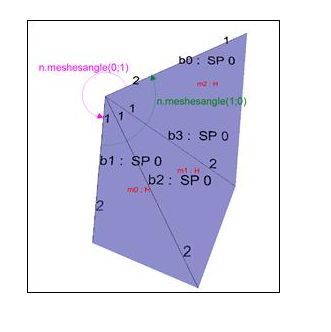
- Availability :
n.mesh_thickness(&1)
- return to top list
- Signification: allows to test the thickness of a mesh at the node
- Use case : all
- Conventions :
- Parameter : &1 : index of the mesh in the assembly node whose thickness we want to know
- Values : >=0
- Example :
Note: The result can also be obtained by passing through the variable: n.Vmeshes(&1).thickness
- Availability :
N.p...
n.Paramvalue
- return to top list
- Signification: Avalaibility To check
- Use case :
- Conventions :
- Values :
- Example :
- Availability : 2.1
n.position
-
Signification: allows to know the position of a node in a frame (frame and opening)
-
Use case : frame
-
Conventions : - Rule for determining the value of n.position : The code for the node position corresponds to that of the first bar (b0) in the assembly node.
- Numbering convention node position in a frame:
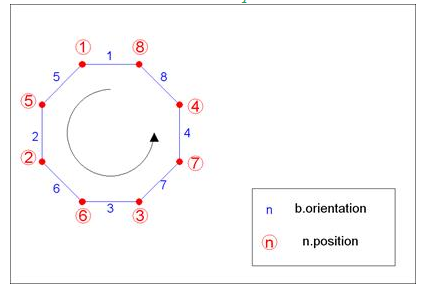
-
Values :
-
Example : In a frame: Let's take the case of a sliding sash as an example. Here is the situation that we want to set for the connections at the nodes of the opening frame: vertical bars
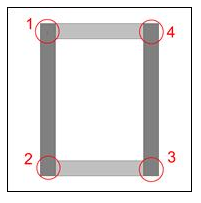
-
Availability :
N.s...
n.stylebeamindex(&1;&2)
-
Signification: Returns the index of the bar in the node whose xth bar is of the style specified in parameter &1
-
Use case : all
-
Conventions : Take into account the direction of travel of the node: trigonometric direction. See also Convention for determining node code.
-
Parameter :
-
&1 : Style of the bar (see convention ([BAR PILLING-UP] (hwps/summary/HWPS-bar-style-convention.md))
-
&2 : xth bar of this style
- Note parameter &2: The numbering of the xth bar parameter starts at 0
-
-
Values : >=0 (integer value)
Note: When the program does not find a bar following the parameters &1 and &2, the value returned by the variable is -1000
-
Example : In a conservatory: What is the index of the bar in the node of the second chevron style bar against wall?
n.stylebeamindex(BSWALLRAFTER;1)=
- Availability :
N.v...
n.variable_float(&1)
- return to top list
- Signification:
- Use case : all``
- Conventions :
- Parameter : &1 : Name of the variable text in the tree of the assembly node
- Values :
- Example : in progress
- Availability :
n.variable_integer(&1)
- return to top list
- Signification:
- Use case : all``
- Conventions :
- Parameter : &1 : Name of the variable text in the tree of the assembly node
- Values :
- Example : in progress
- Availability :
n.variable_string(&1)
- return to top list
- Signification:
- Use case : all``
- Conventions :
- Parameter : &1 : Name of the variable text in the tree of the assembly node
- Values :
- Example : in progress
- Availability :
n.Vbeams(&1)
- return to top list
- Signification: allows you to access the variables of a bar object in an assembly node
- Use case : all``
- Conventions : the expression n.Vbeams(). then replaces the character b. of the variable of the bar object
- Parameter : &1 : index of the mesh in the node
- Values :
- Example : in a conservatory In the node below, we wish to test the slope of the mesh of index 2 (m2)
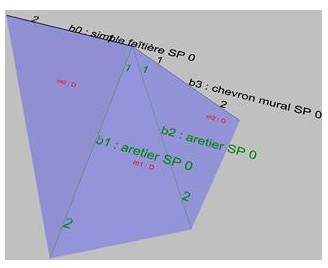
If n.Vmeshes(2).slope>10 then ...
- Availability :
N.x...
n.x
- return to top list
- Signification: returns the x-coordinate of the node (in the construction frame)
- Use case : all
- Conventions :
- Values :
- Example : in progress
- Availability :
N.y...
n.y
- return to top list
- Signification: returns the y-coordinate of the node (in the construction frame)
- Use case : all
- Conventions :
- Values :
- Example : in progress
- Availability :
N.z...
n.z
- return to top list
- Signification: returns the z-coordinate of the node (in the construction frame)
- Use case : All except frame
- Conventions : In a frame, consider the mesh on the ground plane, in the Z=0 plane
- Values :
- Example : in progress
- Availability :
Object Mesh: M.
M.a...
m.AreaHeight(&1;&2)
- return to top list
- Signification: returns the height of the surface defined by point &1 on layer &2 of the mesh
- Use case : all
- Conventions :

-
Parameter :
-
&1 : Point type defined by a "Surface definition point action".
-
&2 : layer index For multi-filling, the layer numbering starts at 1 Layer 0 being the index when the mesh contains a simple filling
-
-
Values : >=0
-
Example : m.AreaWidth(P_AREA;0) returns the width of the area defined by the point of type P_AREA in layer 0 of the mesh
-
Availability :
m.AreaWidth(&1;&2)
- return to top list
- Signification: returns the width of the surface defined by point &1 on layer &2 of the mesh
- Use case : all
- Conventions :
- Parameter :
- &1 : Point type defined by a "Surface definition point action".
- &2 : layer index For multi-filling, the layer numbering starts at 1 Layer 0 being the index when the mesh contains a simple filling
- Values : >=0
- Example : m.AreaWidth(P_AREA;0) returns the width of the area defined by the point of type P_AREA in layer 0 of the mesh
- Availability :
M.b...
m.Beamcount
- return to top list
- Signification: returns the number of bars surrounding the mesh
- Use case : all
- Conventions :
- Values : >=0
- Example : Test on a triangular mesh : m.beamcount=3
- Availability :
M.c...
m.codeQ(&1;&2)
-
Signification: allows to test if the codeQ of the mesh is included in the codeQ interval whose limits are defined by &1 and &2
-
Use case : all
-
Conventions :
- &1 = codeQ value from which the search starts
- &2 = codeQ value at which the search ends
-
Values : >=0
-
Example : In a node of a curtain wall, we want to know if the mesh "0" contains a frame with at least one door type opening system whose codeQ is between 8000 and 8200
--> n.VMeshes(0).codeq(8000;8200)>0
- Availability :
M.f...
m.fillingtype
-
Signification: allows to test the type of the content of a mesh (internal object of a mesh)
-
Use case : all
-
Conventions :
-
Values : The expression generator recognizes both values and constants
- All objects = FTALL or -3
- Ventilator = FTAERATOR or -1
- Glazing = FTGLASS or 0
- Twin sheet (polycarbonate) = FTPOLY or 1
- Panel = FTPANEL or 2
- Filling (panel or glazing or polycarbonate) = FTFILLINGS
- 2D structure (frame) = FTFRAME or 3
- empty = FTEMPTY
- Filling by profiles= CG_FTPROFILS or 4
-
Example : n the expression generator it is now possible to write :
If m.fillingtype=FTGLASS then ...
OR
If m.fillingtype=0
-
Availability :
m.fillingtypeId(&1)
- return to top list
- Signification: allows to test the type of the content of a layer of the current mesh when using multi-fills
- Use case : all
- Conventions :
- Parameter : &1 : layer index For multi-filling, the layer numbering starts at 1 Layer 0 being the index when the mesh contains a single fill
- Values : >=0
- Example :
- Availability :
M.h...
m.height
- return to top list
- Signification: returns the height of the inside space (including mesh + glazing/shutter/structure removal)
- Use case : all
- Conventions :
- Values : >=0
- Example : in progress
- Availability :
m.heightId(&1)
- return to top list
- Signification: returns the height of the inside space of one layer of the mesh (layer + glazing shrinkage) when using multi-fillings
- Use case : all
- Conventions :
- Parameter : &1 : layer index For multi-filling, the layer index numbering starts at 1 Layer 0 being the index when the mesh contains a simple filling
- Values : >=0
- Example : in progress
- Availability :
M.i...
m.Id
- return to top list
- Signification: Returns the number of the mesh being calculated.
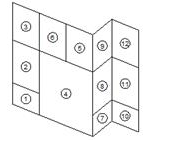
- Use case : all
- Conventions : The numbering starts at "0". The identification of meshes at the level of documents starts at "1". To get the correspondence, use "m.Id +1".
- Values : >=0
- Example : I want to indicate by a warning message in the documents that an item in a mesh needs attention. ("The reducer linked to mesh 4 of bar 1 could not be placed"). Expression in the message: m.ID+1 (for the numbering of the bars refer to b.Id )
- Availability :
M.l...
m.layercount
- return to top list
- Signification: returns the number of layers available at a mesh level
- Use case : all
- Conventions :
- Values :
- If no filling or no multi-filling = 1
- If single filling in the mesh = 1
- If multi-filling>=1
- Example : in progress
- Availability :
m.lydistance(&1;&2;&3;&4)
-
Signification: Allows to measure the distance between 2 layers of a multi-fill at the level of a mesh. (distance from the inner or outer level of a layer to the inner or outer level of another layer)
-
Use case : all
-
Conventions :
-
Parameter :
-
&1 : index of the first layer For multi-filling, the layer index numbering starts at 1 Layer 0 being the index when the mesh contains a single filling
-
&2 : specify "Interior" or "Exterior" to take the measurement from the inside or outside of the filling
-
&3 : index of the second layer
-
&4 : specify "Interior" or "Exterior" to take the measurement from the interior or exterior face of the filling
-
-
Values :
- If no filling or no multi-filling = ?
- If single filling in the mesh = ?
- If multi-filling>=0
-
Example : m.lydistance(1;exterior;6;exterior)
-
Availability :
M.n...
m.Nodecount
- return to top list
- Signification: returns the number of nodes surrounding the mesh
- Use case : all
- Conventions :
- Values : >=2
- Example : Test on a triangular mesh : m.nodecount=3
- Availability :
M.o...
m.orthogonalbase
- return to top list
- Signification: indicates whether the frame mesh has an orthogonal base
- Use case : frame
- Conventions :
- Values :
Boolean expression can be written either :
- without the equality symbol: m.orthogonalbase
- =1
- =TRUE
- Example :
- Availability :
M.p...
m.parallelogram
- return to top list
- Signification: indicates if the frame mesh is a parallelogram (opposite sides 2 to 2 parallel)
- Use case : frame
- Conventions :
- Values :
Boolean expression can be written either :
- without the equality symbol: m.parallelogram
- =1
- =TRUE
- Example : in progress
- Availability :
m.PlaneAreaHeight (&1;&2)
- return to top list
- Signification: returns the height of the surface defined by point &1 for layer &2 of the mesh, at the level of the mesh plane (i.e. on the surface of the meshes adjacent to m in the same plane)
- Use case : all
- Conventions :
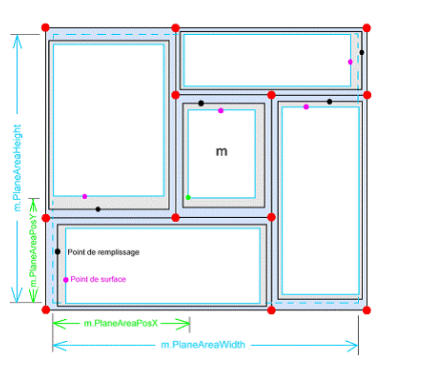
-
Parameter :
- &1 : Point type defined by a "Surface definition point action".
- &2 : Layer index For multi-filling, the layer numbering starts at 1 Layer 0 being the index when the mesh contains a simple fill
-
Values : >=0
-
Example : in progress
-
Availability :
m.PlaneAreaPosX(&1;&2)
- return to top list
- Signification: returns the horizontal position (in X) of the lower right corner of the surface defined by point &1 for layer &2 of the mesh, at the level of the mesh plane (i.e. on the surface of meshes adjacent to m in the same plane)
- Use case : all
- Conventions :
- Values : >=0
- Example : in progress
- Availability :
m.PlaneAreaPosY(&1;&2)
-
Signification: returns the vertical position (in Y) of the lower right corner of the surface defined by point &1 for layer &2 of the mesh, at the level of the mesh plane (i.e. on the surface of meshes adjacent to m in the same plane)
-
Use case : all
-
Conventions :
-
Parameter :
-
&1 : Point type defined by a "Surface definition point action".
-
&2 : Layer index
For multi-filling, the layer numbering starts at 1 Layer 0 being the index when the mesh contains a simple fill
-
-
Values : >=0
-
Example : in progress
-
Availability :
m.PlaneAreaWidth(&1;&2)
-
Signification: returns the width of the surface defined by point &1 for layer &2 of the mesh, at the level of the mesh plane (i.e. on the surface of the meshes adjacent to m in the same plane)
-
Use case : all
-
Conventions :
-
Parameter :
- &1 : Point type defined by a "Surface definition point action".
- &2 : Layer index For multi-filling, the layer numbering starts at 1 Layer 0 being the index when the mesh contains a simple fill
-
Values : >=0
-
Example : in progress
-
Availability :
m.PlaneHeight
- return to top list
- Signification: returns the height of the infill area (mesh + glazing/shutter/structure shrinkage included) at the plane of the mesh (i.e. on the surface of adjacent meshes at m in the same plane)
- Use case : all
- Conventions :
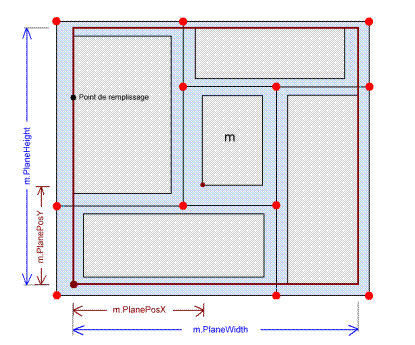
- Values : >=0
- Example : in progress
- Availability :
m.PlanePosX
- return to top list
- Signification: returns the X-position of the lower right corner of the infill footprint (mesh + glazing/glass/structure shrinkage included) at the mesh plane (i.e. on the surface of adjacent meshes at m in the same plane)
- Use case : all
- Conventions :
- Values : >=0
- Example : in progress
- Availability :
m.PlanePosY
- return to top list
- Signification: returns the Y-position of the lower right corner of the infill footprint (mesh + glazing/glass/structure shrinkage included) at the mesh plane (i.e. on the surface of adjacent meshes at m in the same plane)
- Use case : all
- Conventions :
- Values : >=0
- Example : in progress
- Availability :
m.PlaneWidth
- return to top list
- Signification: refers to the width of the infill area (mesh + glazing/glass/structure shrinkage included) at the plane of the mesh (i.e. on the surface of adjacent meshes at m in the same plane)
- Use case : Chassis: Series, construction model, mesh stacking
- Conventions :
- Values : >=0
- Example : in progress
- Availability :
M.r...
m.rectangle
-
Signification: Allows to know if the mesh is rectangular
-
Use case : all
-
Conventions :
-
Values : Boolean expression can be written either :
- without the equality symbol : m.rectangle
-=1
-=TRUE
-
Example : In the visibility of a sliding frame series: The series should only be visible when the mesh is rectangular:
If m.rectangle Then...
OR
If m.rectangle=1 Then...
OR
If m.rectangle=TRUE Then...
-
Availability :
m.RectangleId(&1)
-
Signification: Allows to know if a layer of the mesh is rectangular in shape when using multi-fills
-
Use case : all
-
Conventions :
-
Parameter : &1 : layer index For multi-filling, the layer index numbering starts at 1 Layer 0 being the index when the mesh contains a simple filling
-
Values : Boolean expression can be written either :
- without the equality symbol : m.rectangle
-=1
-=TRUE
-
Example :
-
Availability :
M.s...
m.slope
- return to top list
- Signification: returns the slope of the mesh
- Use case : All except chassis
- Conventions :
- Values : >=0
- Example : in progress
- Availability :
M.t...
m.thickness
- return to top list
- Signification: Thickness of mesh content (filling, aerator, ...)
- Use case : All
- Conventions : Note: Filling thickness: In a fill item, this is the thickness imposed by the parameterizer or user, not the actual thickness calculated by the program.
- Values : >=0
- Example : in progress
- Availability :
m.thicknessId(&1)
- return to top list
- Signification: Thickness of the content of a layer of the mesh when using the multi-fill
- Use case : All
- Conventions : Note: Filling thickness: In a fill item, this is the thickness imposed by the parameterizer or user, not the actual thickness calculated by the program.
- Parameter : &1 : layer index For multi-filling, the layer index numbering starts at 1 , Layer 0 being the index when the mesh contains a single fill
- Values : >=0
- Example : in progress
- Availability :
M.v...
m.VBeams(&1)
- return to top list
- Signification: allows to access the variables of the bar object bordering the mesh
- Use case : All
- Conventions : the expression m.VBeams(). then replaces the character b. of the variable of the bar object
- Parameter : &1 : index of the bar to be accessed around the mesh
- Values :
- Example : Count the number of frame cross bars surrounding the mesh PUSH stack_N 0 For INDEX_1 = 0 until m.beamcount-1 If m.vBeams(INDEX_1).style = BSFRAMETRANSOM Then PUT stack_N stack.geti(stack_N)+1
- Availability :
m.VNodes(&1)
- return to top list
- Signification: is used to access the variables of the assembly node object bordering the mesh
- Use case : All
- Conventions : the expression m.VNodes(). then replaces the character n. of the variable of the bar object
- Parameter : &1 : index of the node we want to access around the mesh
- Values :
- Example : in progress
- Availability :
M.w...
m.width
- return to top list
- Signification: returns the width of the inside space (mesh + shrinkage of glazing/opening/structure included)
- Use case : All
- Conventions : Note: mesh seen in 2D (0,0). Corresponds to the width of the inside space box of the mesh
- Values : >=0
- Example : in progress
- Availability :
m.widthId(&1)
- return to top list
- Signification: returns the width of the inside space of a layer of the mesh (Layer + fill indentation) when using the multi-fill
- Use case : All
- Conventions : Note: mesh seen in 2D (0,0). Corresponds to the width of the inside space box of the mesh
- Parameter : &1 : layer index For multi-filling, the layer index numbering starts at 1 , Layer 0 being the index when the mesh contains a simple filling
- Values : >=0
- Example : in progress
- Availability :
Object Opening: O.
O.a...
o.Area
- return to top list
- Signification: Avalaibility To check
- Use case :
- Conventions :
- Values :
- Example :
- Availability :
O.c...
o.containsStyle(&1)
- return to top list
- Signification: allows you to test the presence of one or more bar styles
- Use case : All
- Conventions :
- Parameter : &1 : bar style : see convention ([BAR PILLING-UP] (hwps/summary/HWPS-bar-style-convention.md))
- Values : >0
- Example : in progress
- Availability :
o.ConstructionType(&1)
- return to top list
- Signification: Avalaibility To check
- Use case :
- Conventions :
- Values :
- Example :
- Availability :
o.Cotation(&1)
- return to top list
- Signification: Avalaibility To check
- Use case :
- Conventions :
- Values :
- Example :
- Availability :
o.CountBeam(&1)
- return to top list
- Signification: Avalaibility To check
- Use case :
- Conventions :
- Values :
- Example :
- Availability :
o.CountMesh(&1)
- return to top list
- Signification: Avalaibility To check
- Use case :
- Conventions :
- Values :
- Example :
- Availability :
O.f...
o.fillingcount
- return to top list
- Signification: allows you to test the number of fills in an opening structure
- Use case : All
- Conventions :
- Values : >0
- Example : in progress
- Availability :
o.findedrpoint(&1 ;&2)
- return to top list
- Signification: Allows to know if there is on the bar defined in parameter &2 contains a section with a point "Rotation point".
- Use case : To parameterize the animation of the opening processes
- Conventions :
- Parameter :
- &1 : Leaf index (value of index)
- &2 : Bar index
- Values : >0
- Example : in progress
- Availability :
O.h...
o.hashardware
- return to top list
- Signification: allows to know if the sash has hardware
- Use case : Opening; stacking of frame structure
- Conventions :
- Values : Boolean expression can be written either :
- without the equality symbol: o.hashardware
- o.hashardware=1
- o.hashardware=TRUE Note:
If a hardware variable is used in the frame structure stacking procedure and there is no hardware: Incorrect expression. Before testing on q., test o.hashardware
- Example :
- Availability :
O.m...
o.model
- return to top list
- Signification: returns the value of the sash construction model variable See also the simple variable Model
- Use case : Frame opening; frame structure stacking
- Conventions :
- Values :
- Example : in progress
- Availability :
O.p...
o.ParentS
- return to top list
- Signification : Avalaibility To check
- Use case :
- Conventions :
- Values :
- Example :
- Availability :
O.s...
o.SlopeMax
- return to top list
- Signification : Avalaibility To check
- Use case :
- Conventions :
- Values :
- Example :
- Availability :
o.SlopeMin
- return to top list
- Signification : Avalaibility To check
- Use case :
- Conventions :
- Values :
- Example :
- Availability :
O.t...
o.thicknessMax(&1 ;&2 ;&3)
- return to top list
- Signification : Avalaibility To check
- Use case :
- Conventions :
- Values :
- Example :
- Availability :
o.thicknessMin(&1 ;&2 ;&3)
- return to top list
- Signification : Avalaibility To check
- Use case :
- Conventions :
- Values :
- Example :
- Availability :
O.v...
o.vantailcount
-
Signification: allows to know the number of elements, leaves, of the opening process of the sash
-
Use case : Opening in frame; structure stacking
-
Conventions :
-
Values : >=0
-
Example : In frame : I want to know if I have a double sash instead of a single sash,
if o.vantailcount=2
-
Availability :
o.variable_float(&1)
- return to top list
- Signification: expression allowing to test a variable of the tree of a structure construction model opening
- Use case : all
- Conventions :
- Parameter : &1 : name of the text object assigned to the variable
- Values :
- Example : in progress
- Availability :
o.variable_integer(&1)
- return to top list
- Signification: expression allowing to test a variable of the tree of a structure construction model opening
- Use case : all
- Conventions :
- Parameter : &1 : name of the text object assigned to the variable
- Values :
- Example : in progress
- Availability :
o.variable_string(&1)
- return to top list
- Signification: expression allowing to test a variable of the tree of a structure construction model opening
- Use case : all
- Conventions :
- Parameter : &1 : name of the text object assigned to the variable
- Values :
- Example : in progress
- Availability :
o.vstructure(&1)
- return to top list
- Signification: expression allowing to test a variable of a sash from
- Use case : Frames
- Conventions : To use on a structure pilling-up from the outer frame or in all procedures in a innerframe
- Parameter : &1 : Index of the sash
- Values : from 0 to n.vantailcount-1
- Example :
- o.vstructure(0).a1 allows to know the A1 value of the first sash
- o.vstructure(2).width allows to know the width of the third sash
- Availability : 2.3
O.w...
O.Weight
- return to top list
- Signification: Return the total weight of the current sash
- Use case : Opening model
- Conventions : the weight of an article is imported with the import price
- Values : numerical
- Example :
- Availability : since 2.1
O.x...
o.XPSVariableExist()
- return to top list
- Signification : Avalaibility To check
- Use case :
- Conventions :
- Values :
- Example :
- Availability :
o.XPSVariable_Float()
- return to top list
- Signification : Avalaibility To check
- Use case :
- Conventions :
- Values :
- Example :
- Availability :
o.XPSVariable_Integer()
- return to top list
- Signification : Avalaibility To check
- Use case :
- Conventions :
- Values :
- Example :
- Availability :
o.XPSVariable_String()
- return to top list
- Signification : Avalaibility To check
- Use case :
- Conventions :
- Values :
- Example :
- Availability :
Object Profile: P.
P.a...
p.AngleCount1
- return to top list
- Signification : Avalaibility To check
- Use case :
- Conventions :
- Values :
- Example :
- Availability :
p.AngleCount2
- return to top list
- Signification : Avalaibility To check
- Use case :
- Conventions :
- Values :
- Example :
- Availability :
P.b...
p.beam.
-
Signification: allows access to the variables of the bar object (b.) on which the profile is extruded
-
Use case : all
-
Conventions :
-
Values : >=0
-
Example : I want to test if the current profile is extruded on a channel bar
If p.beam.style=BSGUTTER Then...
-
Availability :
p.BeamClosoirCount
- return to top list
- Signification : Avalaibility To check
- Use case :
- Conventions :
- Values :
- Example :
- Availability :
p.BeamClosoirID
- return to top list
- Signification : Avalaibility To check
- Use case :
- Conventions :
- Values :
- Example :
- Availability :
P.c...
p.childrencount
- return to top list
- Signification: allows you to know and test the number of profiles stacked on the current profile
- Use case : all
- Conventions :
- Values : >=0
- Example : in progress
- Availability :
p.containspoint(&1)
-
Signification: allows to test if the profile section contains the point specified in parameter &1
-
Use case : all
-
Conventions :
-
Parameter : &1 : parameter value of the point we want to test
-
Values : >=0
- : = 0 does not contain
- : = 1 contains
- : > 0 contains at least once the point
-
Example : In the frame: I would like to know if the profile contains the point mauclair/battement :
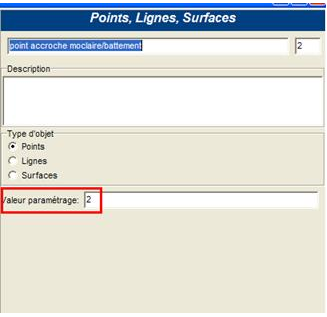
-
if p.containspoint(2)=0 then : if the profile does not contain the point then...
-
if p.containspoint(2)>=1 then : if the profile contains the point then...
-
Availability :
p.containsline(&1)
-
Signification: allows to test if the profile section contains the line specified in parameter &1
-
Use case : all
-
Conventions :
-
Parameter : &1 : parameter value of the line you want to test
-
Values : >=0
- : = 0 does not contain
- : = 1 contains
- : > 0 contains at least once the point
-
Example : in progress
-
Availability :
p.countMH
- return to top list
- Signification: returns the number of horizontal symmetries that the section has undergone
- Use case : all
- Conventions :
- Values : >=0
- Example : in progress
- Availability :
p.countMV
- return to top list
- Signification: returns the number of vertical symmetries that the section has undergone
- Use case : all
- Conventions :
- Values : >=0
- Example : in progress
- Availability :
p.ClosoirPosition
- return to top list
- Signification : Avalaibility To check
- Use case :
- Conventions :
- Values :
- Example :
- Availability :
P.e...
p.ExtrusionMode
-
Signification: returns the extrusion type of the profile
-
Use case : all
-
Conventions :
-
Values : >=0
- : = 0 extruded to the bar
- : = 1 extruded mesh side 1
- : ...
-
Example : in progress
-
Availability :
P.h...
p.H1
- return to top list
- Signification : Avalaibility To check
- Use case :
- Conventions :
- Values :
- Example :
- Availability :
p.H1P
- return to top list
- Signification : Avalaibility To check
- Use case :
- Conventions :
- Values :
- Example :
- Availability :
p.H2
- return to top list
- Signification : Avalaibility To check
- Use case :
- Conventions :
- Values :
- Example :
- Availability :
p.H2P
- return to top list
- Signification : Avalaibility To check
- Use case :
- Conventions :
- Values :
- Example :
- Availability :
P.i...
p.id
- return to top list
- Signification: allows you to test the ID of the profile item
- Use case : all
- Conventions :
- Values : >=0 Returns the database ID of the current profile item
- Example : in progress
- Availability :
- return to top list
- Signification: allows you to test the length of the current profile
- Use case : all
- Conventions :
- Values : >=0
- Example : in progress
- Availability :
p.LinearBoundingMass
- return to top list
- Signification : Avalaibility To check
- Use case :
- Conventions :
- Values :
- Example :
- Availability :
P.n...
p.name
- return to top list
- Signification: allows you to test the name of the article object in the current profile
- Use case : all
- Conventions :
- Values : >=0 Returns the database ID of the current profile item
- Example : in progress
- Availability :
p.node1
- return to top list
- Signification: allows access to node 1 of the bar on which the profile is extruded
- Use case : all
- Conventions :
- Values : See the variables of the object node
- Example : in progress
- Availability :
p.node2
- return to top list
- Signification: allows access to node 2 of the bar on which the profile is extruded
- Use case : all
- Conventions :
- Values : See the variables of the object node
- Example : in progress
- Availability :
P.o...
p.oldparent.
- return to top list
- Signification: allows access to the object variables p. of the first parent profile stacked on the bar
- Use case : all
- Conventions :
- Values : see the variables of the object p.
- Example : in progress
- Availability :
P.p...
p.parent.
- return to top list
- Signification: allows access to the object variables of the parent profile (the parent profile is the profile on which the current one is stacked)
- Use case : all
- Conventions :
- Values : see the variables of the object p.
- Example : p.parent.countMH : allows to know the number of horizontal symmetry of the parent profile
- Availability :
p.parentvalue(&1)
- return to top list
- Signification: returns the parameter value of the positioned profile action of the parent profile whose parent level is defined in parameter &1
- Use case : all
- Conventions :
- Parameter : &1 : parent profile level
Note: Parent profile level: 1 = the first parent
- Values : >=1
- Example :
- Availability :
p.PFpositionID
-
Signification: returns the position of a profile in a profile fill
-
Use case : filling profile by profile
-
Conventions :
-
Values : >=0
-
Example : to test if the profile is in central position
If p.PFpositionID=TRUNC(pf.ElementCount/2) Then...
-
Availability :
p.positionID
-
Signification: returns the position of a profile in a profile fill - by profile fill action
-
Use case : filling profile by profile
-
Conventions :
-
Values : >=0
-
Example : to test if the current profile is in even (or odd) position in the fill
If PAIR(p.positionID) <> 0 Then...
-
Availability :
p.projLength
- return to top list
- Signification: returns the projected length of the profile
- Use case : curved profile
- Conventions :
- Values : >=0
- Example : In the case of a bent profile (e.g. gendarme hat) p.length returns the actual length information of the profile (length without taking the shape of the bend into account). P.projLength returns the useful length on the already bent profile
- Availability :
p.PackagingMode
- return to top list
- Signification:
- Use case :
- Conventions :
- Values :
- Example :
- Availability : To check
P.r...
p.reference
- return to top list
- Signification: allows you to test the reference field of the current profile item
- Use case : all
- Conventions :
- Values :
- Example : in progress
- Availability :
p.removed
-
Signification: allows you to see if a profile has been deleted as a result of a profile join, profile cut to node, or profile delete action.
-
Use case : all
-
Conventions :
-
Values : Boolean expression can be written either :
- without the equality symbol: p.removed
- p.removed=1
- p.removed=TRUE
-
Example : to know if we are on the cut profile
If CG_NOT(p.removed) Then ...
-
Availability :
P.v...
p.value
-
Signification: returns the setting value of the parent profile (defined in the positioned profile action of the parent profile)
-
Use case : all
-
Conventions :
-
Values : >=1
-
Example : Two of the same "upright" items are present on a bar. → On one of them only should a joining profile be stacked. I specify a setting value >0 in the positioned profile action of this one. In the stacking procedure of the rising article I can test: If p.value=1 then
-
Availability :
p.VMesh
- return to top list
- Signification: allows access to the information of the mesh associated with a profile extruded to the mesh
- Use case : profil extrudé à la maille
- Conventions :
- Values :
- Example : p.VMesh.ID ----> returns the value of the mesh ID associated with the profile p
- Availability :
Object Filling Profile: PF.
Pf.d...
pf.DivMeshesCount
-
Signification: returns the number of divisions defined in the mesh
-
Use case : Filling by profiles by zone
-
Conventions :
-
Values : >=0
- 0 si il s'agit d'un remplissage par profils sans définition de zone
-
Example :
-
Availability : from version 2.1.2.116
Pf.e...
pf.ElementCount
- return to top list
- Signification: returns the number of bars/blades composing the filler item per profile
- Use case : procedure of stacking at the mesh of a profile - procedure/action of filling by profiles -
- Conventions :
- Values : >=0
- Example : in progress
- Availability : from version 2.1.2.116
Pf.p...
pf.ParamValue
- return to top list
- Signification: returns the parameter value of the "filling by profiles" item
- Use case : procedure of stacking at the mesh of a profile - procedure/action of filling by profiles -
- Conventions :
- Values : User defined value
- Example : in progress
- Availability :
pf.PBFdata(&1;&2;&3)
-
Signification: returns the information of the filling by profiles according to the parameters &1,&2 and &3 defined in the function
-
Use case : procedure for stacking at the mesh of a profile
-
Conventions :
-
Parameter :
-
&1 : extremity constant :
- CG_EXTREMITY_1
- CG_EXTREMITY_2
- CG_PLANE_EXTREMITY_1
- CG_PLANE_EXTREMITY_2
- Intermediate index Note 1 : &1 indexed on 1 index increasing in the direction 1->2 of the reception profile
-
&2 : constant relative to the distribution of the profiles on the filling
-
CG_PBF_LB : width of the first bar (or first slat) which abuts on a profile outside the filling, on the end side &1 of the receiving profile
-
CG_PBF_EB : distance to the first bar (or first slat) that abuts on a profile outside the filling, on the end side &1 of the receiving profile
-
CG_PBF_EB_I : distance between 2 bars (or slats) &1 and &1+1 which abut on a profile outside the filling.
-
CG_PBF_RB : repetition distance between the first bars (or first slats) that abut on a profile outside the filling, on the end side &1 of the receiving profile
-
CG_PBF_EX : value of the parameterized center distance
-
CG_PBF_LIGHT : returns the signed distance between the surface delimited by the filling point and the surface delimited by the surface point of the filling action by profile
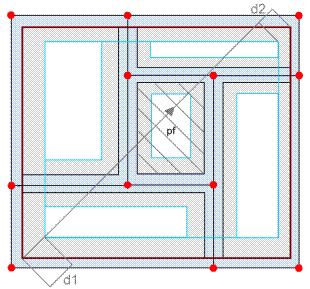 Note :
Note :-
&1 = CG_EXTREMITY_1 the value is calculated on the side where the filling starts
-
&1 = CG_EXTREMITY_2 the value is calculated on the side where the filling ends
-
-
&3 : variable to indicate which profile filling action to consider
- 0 means that we are looking for information related to the first profile filling action that has been set up
- 1 means that we are looking for information related to the second profile filling action that has been set up
- ...
-
-
Values : >0
-
Example1 :
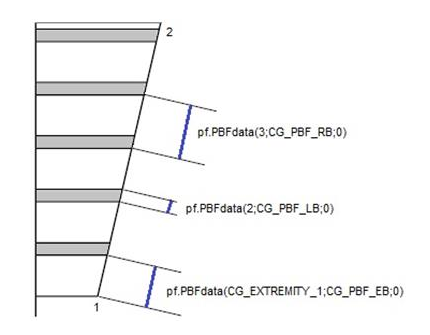
- Note 1: &1=0 corresponds to &1=CG_EXTREMITY_1 and &2=CG_PBF_EB
- Note 2: &1=profiles.count corresponds to &1=CG_EXTREMITY_2 and &2=CG_PBF_EB
-
Example2 :
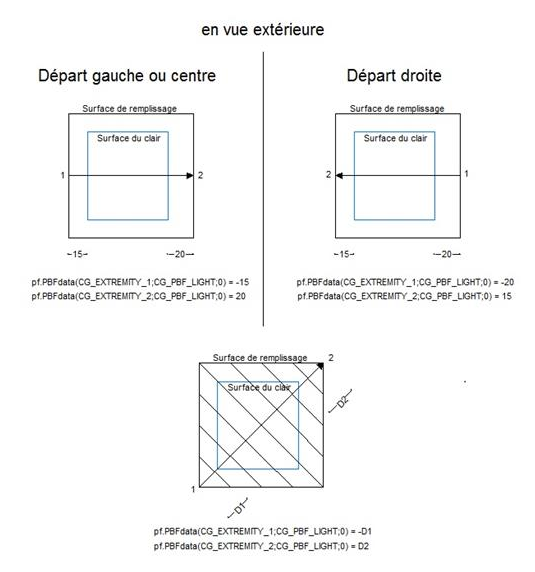
-
Availability :
Pf.v...
pf.Variable_Float(&1)
- return to top list
- Signification: returns the value associated with the variable designated by &1 as a decimal number
- Use case : procedure of stacking at the mesh of a profile - procedure/action of filling by profiles -
- Conventions :
- Parameter : &1 : name of the text object assigned to the variable
- Values :
- Example : in progress
- Availability :
pf.Variable_Integer(&1)
- return to top list
- Signification: returns the value associated with the variable designated by &1 as an integer
- Use case : procedure of stacking at the mesh of a profile - procedure/action of filling by profiles
- Conventions :
- Parameter : &1 : name of the text object assigned to the variable
- Values :
- Example : in progress
- Availability :
pf.Variable_String(&1)
- return to top list
- Signification: returns the value associated with the variable designated by &1 as a string
- Use case : procedure of stacking at the mesh of a profile - procedure/action of filling by profiles
- Conventions :
- Parameter : &1 : name of the text object assigned to the variable
- Values :
- Example : in progress
- Availability :
Object Accessories: Acc.
Acc.i...
acc.ID
- return to top list
- Signification: allows you to test the identifier of the accessory item
- Use case : all
- Conventions :
- Values : >=0 Returns the database ID of the current accessory item
- Example :
- Availability :
Acc.m...
acc.ManuallyRemoved
- return to top list
- Signification : Avalaibility To check
- Use case :
- Conventions :
- Values :
- Example :
- Availability :
Acc.n...
acc.Name
- return to top list
- Signification : Avalaibility To check
- Use case :
- Conventions :
- Values :
- Example :
- Availability :
Acc.p...
acc.PackagingMode
- return to top list
- Signification : Avalaibility To check
- Use case :
- Conventions :
- Values :
- Example :
- Availability :
Acc.n...
acc.Name
- return to top list
- Signification : Avalaibility To check
- Use case :
- Conventions :
- Values :
- Example :
- Availability :
Acc.r...
acc.Reference
- return to top list
- Signification : Avalaibility To check
- Use case :
- Conventions :
- Values :
- Example :
- Availability :
acc.Removed
- return to top list
- Signification : Avalaibility To check
- Use case :
- Conventions :
- Values :
- Example :
- Availability :
Acc.v...
acc.Value
- return to top list
- Signification : Avalaibility To check
- Use case :
- Conventions :
- Values :
- Example :
- Availability :
acc.Variable_Float(&1)
- return to top list
- Signification : Avalaibility To check
- Use case :
- Conventions :
- Values :
- Example :
- Availability :
acc.Variable_Integer(&1)
- return to top list
- Signification : Avalaibility To check
- Use case :
- Conventions :
- Values :
- Example :
- Availability :
acc.Variable_String(&1)
- return to top list
- Signification : Avalaibility To check
- Use case :
- Conventions :
- Values :
- Example :
- Availability :
Object Hardware: Q.
Q.v...
Q.variable_float(&1)
- return to top list
- Signification: expression to test a variable of the hardware tree
- Use case : all
- Conventions :
- Parameter : &1 : name of the text object assigned to the variable
- Values :
- Example : in progress
- Availability :
Q.variable_Integer(&1)
- return to top list
- Signification: expression to test a variable of the hardware tree
- Use case : all
- Conventions :
- Parameter : &1 : name of the text object assigned to the variable
- Values :
- Example : in progress
- Availability :
Q.variable_string(&1)
- return to top list
- Signification: expression to test a variable of the hardware tree
- Use case : all
- Conventions :
- Parameter : &1 : name of the text object assigned to the variable
- Values :
- Example : in progress
- Availability :
Object Structure: S.
S.a...
s.Area
-
Signification : Returns the floor area (overall) of the structure
-
Use case : Conservatory
-
Values : Float (m²)
-
Example : I want to know if my veranda exceeds 20 m².
s.area>20
-
Availability :
S.c...
s.ConstructionType
- return to top list
- Signification: allows you to test the type of construction you are in
- Use case : all
- Conventions : Attention:
For reasons of standardization of the functionalities developed in version 2.1, the values associated with the construction type constants in version 2.0 and 2.1 are not the same. It is therefore strongly advised to use the CG_TSxxx constants in expressions relating to s.ConstructionType rather than the numeric values associated with them.
-
Parameter :
-
Values : >0
- CG_TSFRAME = Frame
- CG_TSCONSERVATORY = Conservatory
- CG_TSCOMPOSITION = Frame composition
- CG_TSCURTAINWALL = Curtain Wall
- CG_TSGATE = Gate
- CG_TSPARAPET = Railing/Fence
- CG_TSPOOLCOVER = Pool Cover
-
Example1 : Visibility condition for a Conservatory type construction
s.ConstructionType=CG_TSCONSERVATORY
-
Example2 : Visibility condition of a series of frames in a conservatory type construction
s.parentS.ConstructionType=CG_TSCONSERVATORY
-
Availability : from version 2.0.1.183 - 2.1.2.125
s.containsStyle(&1)
- return to top list
- Signification: allows to test the presence of a bar property in a structure (be careful not to go down in the substructure)
- Use case : all
- Conventions :
- Parameter : &1 : Style of the bar to be tested
- Values : >=0 returns the number of bars whose style is specified in the &1 parameter
- Example : display a variable if the veranda contains a hip : s.containsStyle(105)>0
- Availability :
s.countbeam("&1")
- return to top list
- Signification: Allows to recover the number of bars of the structure respecting the condition specified in parameter &1
- Use case : can be used in all expressions where the variable 'S' is accessible. However, as we are working at the structure level, it is obvious that the expressions that b. will be able to use will be limited to the wireframe information. This excludes information such as b.variable_integer (directly linked to the parameterization)
- Conventions :
- Parameter : &1 : expression
Note: The expression in the &1 parameter must be enclosed in quotation marks because it must be treated as a string and not as a boolean expression
- Values : >=0
- Example : s.CountBeam(″(b.style=bsPost) AND (b.interiorAngle=45)″): This expression returns the number of 45° posts in the current construction
- Availability :
s.countmesh("&1")
- return to top list
- Signification: Used to retrieve the number of meshes in the structure that meet the condition specified in parameter &1
- Use case : can be used in all expressions where the variable 'S' is accessible.
- Conventions : &1 represents an expression that will be tested for each mesh of the structure.
- Parameter : &1 : expression
Note: The expression in the &1 parameter must be enclosed in quotation marks because it must be treated as a string and not as a boolean expression
- Values : >=0
- Example : s.countmesh(″(m.fillingtype=FTGLASS) AND (m.thickness=24)″) : This expression returns the number of meshes, in the structure, containing a 24 mm glazing.
- Availability :
S.cotation(&1 ;&2 ;&3 ;&4)
-
Signification: this variable allows to calculate a dimension between 2 points defined at the nodes of a structure on the basis of a dimensioning point
-
Use case : Frame, gate
-
Conventions : dimension point actions for distance calculation
-
Parameter :
-
&1 : Name of the first type of dimensioning point for the calculation of the distance
-
&2 : Name of the second type of dimensioning point for the calculation of the distance Attention: The "point to node definition" actions must be placed directly in the assembly node procedure
-
&3: parameters for distance calculation: Use of a combination of the following constants:
-
CG_SCURRENT or CG_SCHILD: ----> CG_SCURRENT: The distance is calculated based on the points found on all nodes of the current structure. Note: In the case of a sash, calculate the distance by traversing all points found on each sash ----> CG_SCHILD : The distance is calculated on the basis of points found only on the leaf whose index is specified in parameter &4 Note: In the case of a dormant, returns the same information as CG_SCURRENT
-
CG_SHEIGHT or CG_SWIDTH or CG_SDISTANCE(*)
---> CG_SHeight : The distance is calculated vertically, in the direction of the height of the 2D structure (distance in Y)
---> CG_SWIDTH : The distance is calculated horizontally, in the direction of the width of the 2D structure (distance in X)
---> CG_SDISTANCE : distance between the 2 points (calculation in X and Y). For this mode of calculation, only the first points found of each type will be used
-
CG_COTMAX or CG_COTMIN ---> CG_COTMAX : It is the largest distance that is calculated among all the points found
---> CG_COTMIN : It is the smallest distance that is calculated among all the points found This parameter is not used in the case of a CG_SDISTANCE calculation
-
-
&4: Index of the leaf whose information you wish to know, the value must be between 0 and the number of leaf-1 Note:
- The numbering of the sashes starts at 0 when looking at the sash from the outsidefrom left to right
- If you wish to know the information of the current sash, you only need to enter the INDEX variable in parameter &4
-
-
Values : >=0 If the expression returns a value of 0, it is possible that the program did not find the points specified in parameters &1 and &2.
- Note debugger: By testing the expression in the menu Tools Parameters in the tool "test an expression", it is possible to have more information about the points that would not have been found.
After testing the expression, run the tool again and test the following expression: ERRORCODE: If the value returned is :
0 : no error
1 : the type of point given in parameter &1 was not found
2 : the type of point indicated in parameter &2 was not found
3 : the point types given in parameters &1 and &2 were not found
- Example : S.cotation(COTESCHASSIS;COTESCHASSIS;CG_SCURRENT+CG_COTMAX+CG_SWIDTH;0)
- Availability :
S.f...
s.fillingcount
- return to top list
- Signification:
- Use case : all
- Conventions :
- Parameter :
- Values :
- Example :
- Availability :
S.p...
S.Param.AggregateValue(&1;"&2";"&3";"&4")
- return to top list
- Signification: Allow to know the aggregate value of an article in a construction (ex:cumulated length or quantity)
- Use case : All
- Conventions : The program scans all the structure and returns the aggregate value of the argument "&4"
- Values : float
- &1 : type of article
- 1 = Profile
- 2 = Accessory
- 4 = Fillings
- &2 :Expression to target where is the searched article
- "1" (all)
- "b.style=xxx"
- ??????? "m.fillingtype=xxx" ??????
- &3 : Expression to determinate the targeted article
- "p.reference=xxx"
- "p.ContainsLine(xxx)"
- "p.Containspoint(xxx)"
- ...
- &4 : Result
- &1 : type of article
result= 1 x argument
- "1" (quantity)
- "p.length"
- "b.Variable_Float(&1)"
- "..."
- Example 1 : I want to know the cumulate length of a profile in a construction
s.param.aggregateValue(1;"b.style=151";"p.reference=P20";"p.length")
s.param.aggregateValue(1;"b.style=151 and b.style=160";"p.reference=P20";"p.length")
- Example 2 : I want to know the cumulate values of a numérical variable on beam
s.param.aggregateValue(1;"b.style=151";"p.reference=P20";"b.Variable_Float(VVAL_SPOTLIGHT_N)")
s.param.aggregateValue(1;"b.paramvalue=1";"p.containsline(351)";"b.Variable_Float(VVAL_SPOTLIGHT_N)")
- Availability : since 2.3.1.2577
S.s...
s.parents
- return to top list
- Signification: communication with the parent structure
- Use case : Frame in a frame
- Conventions : the expression s.parents. replaces the character s. of the variable of the structure object
- Parameter :
- Values :
- Example : Frame of a conservatory mesh In the frame, we want to test a variable of the veranda construction model: s.parents.variable_integer()
- Availability :
s.slopemax
- return to top list
- Signification: returns the maximum slope of the roof meshes of the structure (default value if no roof mesh = 0)
- Use case : Conservatory Note: Do not use the variable in the chassis setting (error property not found).
- Conventions :
- Parameter :
- Values :
- Example :
- Availability :
s.slopemin
- return to top list
- Signification: minimum slope of the roof meshes of the structure (default value if no roof mesh = 360)
- Use case : Conservatory Note: Do not use the variable in the chassis setting (error property not found).
- Conventions :
- Parameter :
- Values :
- Example :
- Availability :
S.t...
s.thicknessMax(&1 ;&2)
- return to top list
- Signification: allows to know the greatest thickness of internal objects of the structure's meshes, whose type of object is defined in parameter &1, the type of mesh in parameter &2
- Use case : all
- Conventions : idem b.thickness
- Parameter :
- &1 : Mesh Type : Type of mesh to take into account in the calculation of the variable
Vertical mesh : constant MTVertical
Horizontal mesh: constant MTHorizontal
Oblique mesh (roof mesh): constant MTOblique
All mesh types: constant MTALL
- Note: In the case of a frame the meshes are horizontal
- &2 : Filling Type : Type of mesh objects to take into account in the calculation of the variable see m.fillingType
- &1 : Mesh Type : Type of mesh to take into account in the calculation of the variable
Vertical mesh : constant MTVertical
Horizontal mesh: constant MTHorizontal
Oblique mesh (roof mesh): constant MTOblique
All mesh types: constant MTALL
- Values : >=0
- Example :
- Availability :
s.thicknessmin(&1)
- return to top list
- Signification: allows to know the smallest thickness of the internal objects of the structure meshes, whose object type is defined in parameter &1, the mesh type in parameter &2
- Use case : all
- Conventions : idem b.thickness
- Parameter : see s.thicknessMax
- Values : >=0
- Example :
- Availability :
S.v...
s.variable_float(&1)
- return to top list
- Signification: expression allowing to test a variable of the tree of a construction model
- Use case : all
- Conventions :
- Parameter : &1 : Name of the text of the variable in the tree of the construction model
- Values :
- Example :
- Availability :
s.variable_integer(&1)
- return to top list
- Signification: expression allowing to test a variable of the tree of a construction model
- Use case : all
- Conventions :
- Parameter : &1 : Name of the text of the variable in the tree of the construction model
- Values :
- Example :
- Availability :
s.variable_string(&1)
- return to top list
- Signification: expression allowing to test a variable of the tree of a construction model
- Use case : all
- Conventions :
- Parameter : &1 : Name of the text of the variable in the tree of the construction model
- Values :
- Example :
- Availability :
s.vstructure(&1)
-
Signification: returns the internal index structure &1
-
Use case : Frames, Gates In the case of a sash type structure, we can query the sash information:
-
o.vstructure(&1).Width to width of the sash &1
-
o.vstructure(&1).Height to the height of the sash &1
-
o.vstructure(&1).A1 to leaf offset A1 &1
-
o.vstructure(&1).A2 at leaf offset A2 &1
-
o.vstructure(&1).indexing to value of leaf indexing &1
-
-
Conventions :
-
Parameter : &1 : index of the element of the internal structure
-
Values : >=0
-
Example : o.vstructure(0).indexing : allows to get the indexing of the first leaf
-
Availability :
S.w...
S.Weight
- return to top list
- Signification: Return the total weight of a construction
- Use case : all
- Conventions : the weight of an article is imported with the import price
- Values : numerical
- Example :
- Availability : since 2.1
S.x...
s.XpsVariableExist(&1)
-
Signification: expression allowing to test if a variable exists in the parametric form of the current construction.
-
Use case : all The objective is to be able to communicate with the parametric shape from the parametrization (thus implying that we work from parametric shapes)
-
Conventions :
-
Parameter : &1 : Name of the variable in the tree of variables of the parametric form
-
Values : Boolean expression can be written either :
- without the equality symbol: s.XpsVariableExist(&1)
- s.XpsVariableExist(&1)=1
- s.XpsVariableExist(&1)=TRUE
-
Example :
-
Availability :
s.xpsvariable_float(&1)
- return to top list
- Signification: expression to test a variable of the variable tree of the parametric form
- Use case : all
- Conventions : Note: It is strongly advised to make a first test to know if the variable exists before continuing to retrieve its value. By default, if the variable does not exist, the program will return 0.
- Parameter :
- &1 : Name of the variable text in the tree of the parametric form
- Note:
For variables of type Text list and Value list, two variables can be tested:
- &1 = name of the variable created by the user
- &1_ID = variable created automatically by the program to retrieve the id of the text or the value in the list.
- Values : floating value (decimal)
- Example :
- Availability :
s.xpsvariable_integer(&1)
- return to top list
- Signification: expression to test a variable of the variable tree of the parametric form
- Use case : all
- Conventions : Note: It is strongly advised to make a first test to know if the variable exists before continuing to retrieve its value. By default, if the variable does not exist, the program will return 0.
- Parameter :
- &1 : Name of the variable text in the tree of the parametric form
- Note :
For variables of type Text list and Value list, two variables can be tested:
- &1 = name of the variable created by the user
- &1_ID = variable created automatically by the program to retrieve the id of the text or the value in the list.
- Values : Full value
- Example :
- Availability :
s.xpsvariable_string(&1)
- return to top list
- Signification: expression to test a variable of the variable tree of the parametric form
- Use case : all
- Conventions : Note: It is strongly advised to make a first test to know if the variable exists before continuing to retrieve its value. By default, if the variable does not exist, the program will return 0.
- Parameter :
- &1 : Name of the variable text in the tree of the parametric form
- Note :
For variables of type Text list and Value list, two variables can be tested:
- &1 = name of the variable created by the user
- &1_ID = variable created automatically by the program to retrieve the id of the text or the value in the list.
- Values : Chain value
- Example :
- Availability :
Object Project: Cg_Project.
Cg_Project.I
Cg_Project.Id
- return to top list
- Signification:
- Use case :
- Conventions :
- Values :
- Example :
- Availability :
Cg_Project.N
Cg_Project.Name
- return to top list
- Signification:
- Use case :
- Conventions :
- Values :
- Example :
- Availability :

